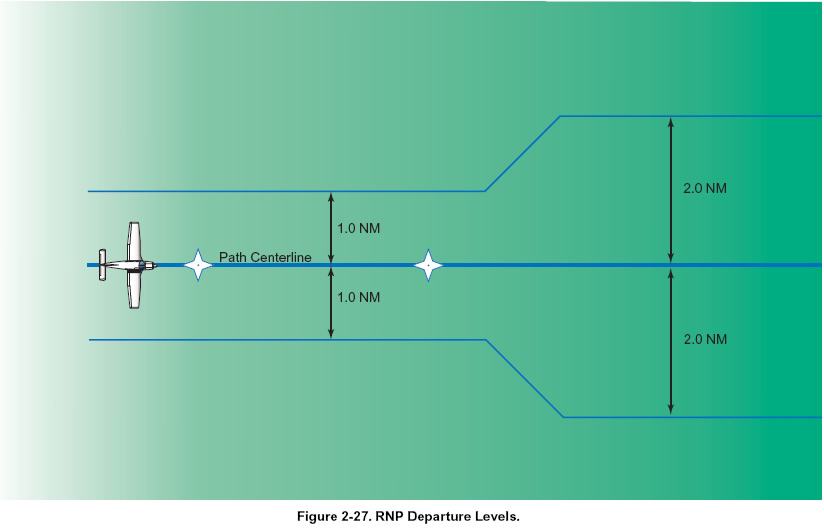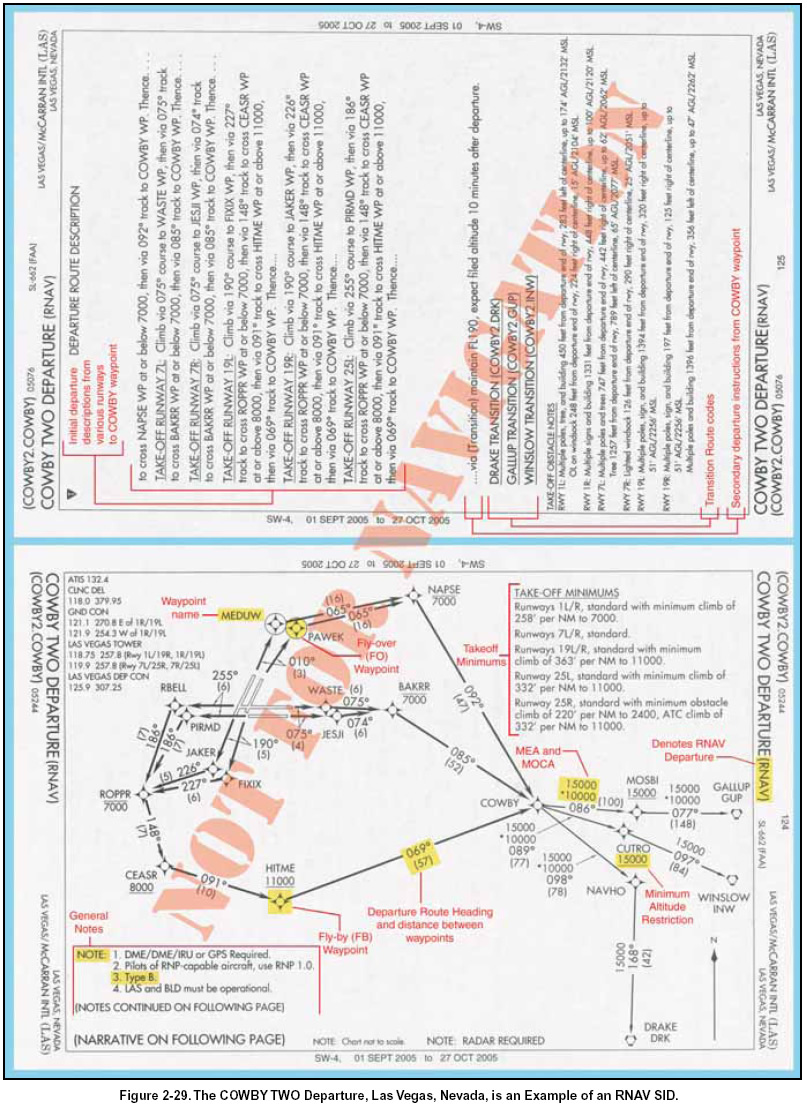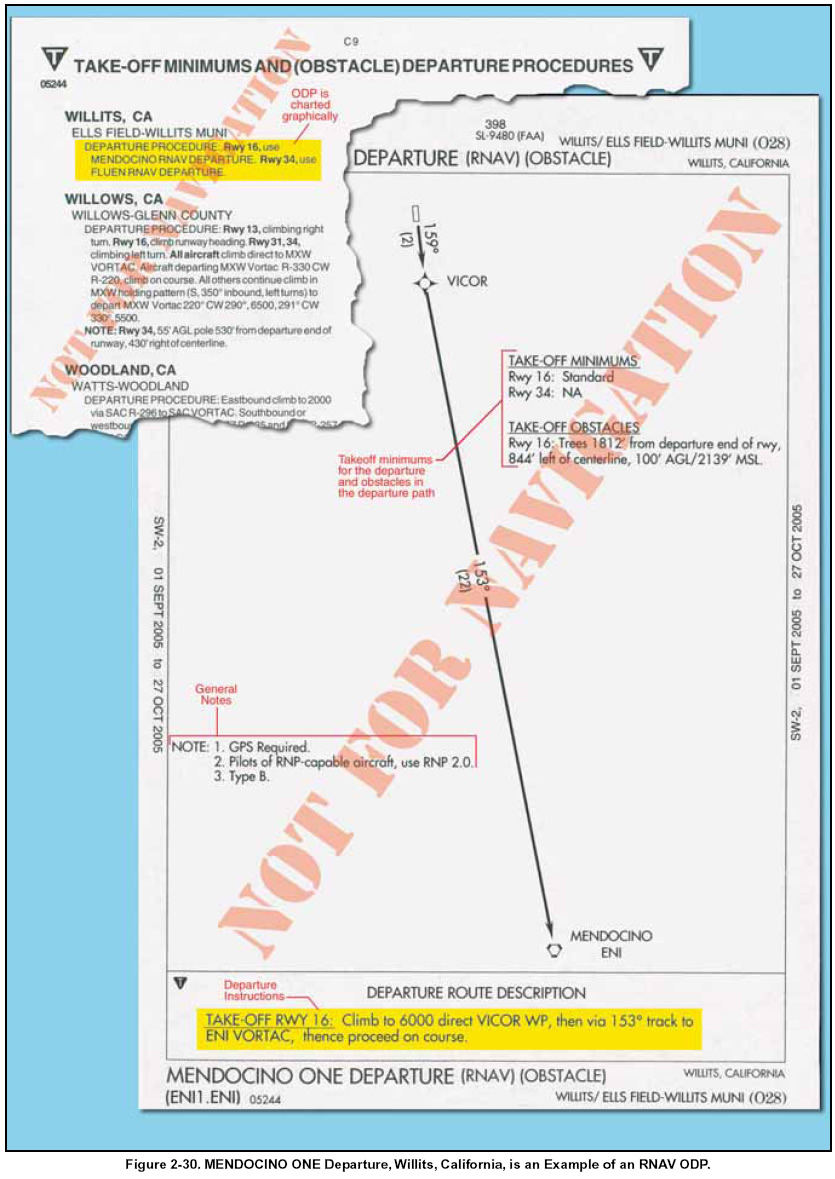 |
|
| INSTRUMENT PROCEDURES HANDBOOK |
|
AREA NAVIGATION DEPARTURES In the past, area navigation (RNAV) was most commonly associated with the station-mover/phantom waypoint technology developed around ground-based Very High Frequency Omni-directional Range (VOR) stations. RNAV today, however, refers to a variety of navigation systems that provide navigation beyond VOR and NDB. RNAV is a method of navigation which permits aircraft operation on any desired flight path within the coverage of station-referenced navigation aids or within the limits of the capability of self-contained aids, or a combination of these. The term also has become synonymous with the concept of “free flight,” the goal of which is to provide easy, direct, efficient, cost-saving traffic management as a result of the inherent flexibility of RNAV. In the past, departure procedures were built around existing ground-based technology and were typically designed to accommodate lower traffic volumes. Often, departure and arrival routes use the same navigation aids creating interdependent, capacity diminishing routes. As a part of the evolving RNAV structure, the FAA has developed departure procedures for pilots flying aircraft equipped with some type of RNAV technology. RNAV allows for the creation of new departure routes that are independent of present fixes and navigation aids. RNAV routing is part of the National Airspace Redesign and is expected to reduce complexity and increase efficiency of terminal airspace. When new RNAV departure procedures are designed with all interests in mind, they require minimal vectoring and communications between pilots and ATC. Usually, each departure procedure includes position, time, and altitude, which increase the ability to predict what the pilot will actually do. All told, RNAV departure procedures have the ability to increase the capacity of terminal airspace by increasing on-time departures, airspace utilization, and improved predictability. If unable to comply with the requirements of an RNAV or required navigation performance (RNP) procedure, pilots need to advise ATC as soon as possible. For example, ". . .N1234, failure of GPS system, unable RNAV, request amended clearance." Pilots are not authorized to fly a published RNAV or RNP procedure unless it is retrievable by the procedure name from the navigation database and conforms to the charted procedure. Pilots shall not change any database waypoint type from a flyby to fly-over, or vice versa. No other modification of database waypoints or creation of user-defined waypoints on published RNAV or RNP procedures is permitted, except to change altitude and/or airspeed waypoint constraints to comply with an ATC clearance/ instruction, or to insert a waypoint along the published route to assist in complying with an ATC instruction, for example, "Climb via the WILIT departure except cross 30 north of CHUCK at/or above FL 210." This is limited only to systems that allow along track waypoint construction. Pilots of aircraft utilizing DME/DME for primary navigation updating shall ensure any required DME stations are in service as determined by NOTAM,ATIS, or ATC advisory. No pilot monitoring of an FMS navigation source is required. While operating on RNAV segments, pilots are encouraged to use the flight director in lateral navigation mode. RNAV terminal procedures may be amended by ATC issuing radar vectors and/or clearances direct to a waypoint. Pilots should avoid premature manual deletion of waypoints from their active "legs" page to allow for rejoining procedures. While operating on RNAV segments, pilots operating /R aircraft shall adhere to any flight manual limitation or operating procedure required to maintain the RNP value specified for the procedure. RNAV DEPARTURE PROCEDURES There are two types of public RNAV SIDs and graphic ODPs. Type A procedures generally start with a heading or vector from the DER, and have an initial RNAV fix around 15 NM from the departure airport. In addition, these procedures require system performance currently met by GPS, DME/DME, or DME/DME/Inertial Reference Unit (IRU) RNAV systems that satisfy the criteria discussed in AC 90-100, U.S. Terminal and En Route Area Navigation (RNAV) Operations. Type A terminal procedures require that the aircraft's track keeping accuracy remain bounded by ±2 NM for 95 percent of the total flight time. For type A procedure RNAV engagement altitudes, the pilot must be able to engage RNAV equipment no later than 2,000 feet above airport elevation. For Type A RNAV DPs, it is recommended that pilots use a CDI/flight director and/or autopilot in lateral navigation mode. Type B procedures generally start with an initial RNAV leg near the DER. In addition, these procedures require system performance currently met by GPS or DME/DME/IRU RNAV systems that satisfy the criteria discussed in AC 90-100. Type B procedures require the aircraft's track keeping accuracy remain bounded by ±1 NM for 95 percent of the total flight time. For type B procedures, the pilot must be able to engage RNAV equipment no later than 500 feet above airport elevation. For Type B RNAV DPs, pilots must use a CDI/flight director and/or autopilot in lateral navigation mode. For Type A RNAV DPs and STARs, these procedures are recommended. Other methods providing an equivalent level of performance may also be acceptable. For Type B RNAV DPs, pilots of aircraft without GPS using DME/DME/IRU must ensure that the aircraft navigation system position is confirmed, within 1,000 feet, at the start point of take-off roll. The use of an automatic or manual runway update is an acceptable means of compliance with this requirement. Other methods providing an equivalent level of performance may also be acceptable. For procedures requiring GPS and/or aircraft approvals requiring GPS, if the navigation system does not automatically alert the flight crew of a loss of GPS, aircraft operators must develop procedures to verify correct GPS operation. If not equipped with GPS, or for multi-sensor systems with GPS that do not alert upon loss of GPS, aircraft must be capable of navigation system updating using DME/DME or DME/DME/IRU for type A and B procedures. AC 90-100 may be used as operational guidance for RNAV ODPs. Pilots of FMS-equipped aircraft, who are assigned an RNAV DP procedure and subsequently receive a change of runway, transition, or procedure, must verify that the appropriate changes are loaded and available for navigation. RNAV departure procedures are developed as SIDs and ODPs—both are charted graphically. An RNAV departure is identifiable by the inclusion of the term RNAV in the title of the departure. From an RNP standpoint, RNAV departure routes are designed with a 1 or 2 NM performance standard. This means you as the pilot and your aircraft equipment must be able to maintain the aircraft within 1 NM or 2 NM either side of route centerline. [Figure 2-27]
Additionally, new waypoint symbols are used in conjunction with RNAV charts. There are two types of waypoints currently in use: fly-by (FB) and fly-over (FO). A fly-by waypoint typically is used in a position at which a change in the course of procedure occurs. Charts represent them with four-pointed stars. This type of waypoint is designed to allow you to anticipate and begin your turn prior to reaching the waypoint, thus providing smoother transitions. Conversely, RNAV charts show a fly-over waypoint as a four-pointed star enclosed in a circle. This type of waypoint is used to denote a missed approach point, a missed approach holding point, or other specific points in space that must be flown over. [Figure 2-28 on page 2-30]
RNAV departure procedures are being developed at a rapid pace to provide RNAV capabilities at all airports. With every chart revision cycle, new RNAV departures are being added for small and large airports. These departures are flown in the same manner as traditional navigation-based departures; you are provided headings, altitudes, navigation waypoint, and departure descriptions. RNAV SIDs are found in the TPP with traditional departure procedures. On the plan view of this procedure, in the lower left corner of the chart, the previous aircraft equipment suffix code and equipment notes have been replaced with note 3, the new type code, Type B RNAV departure procedure. Additionally, ATC has the aircraft equipment suffix code on file from the flight plan. [Figure 2-29 on page 2-31]
RNAV ODPs are always charted graphically, and like other ODPs, a note in the Takeoff Minimums and IFR Obstacle Departure Procedures section refers you to the graphic ODP chart contained in the main body of the TPP. [Figure 2-30 on page 2-32]
There are specific requirements, however, that must be met before using RNAV procedures. Every RNAV departure chart lists general notes and may include specific equipment and performance requirements, as well as the type of RNAV departure procedure in the chart plan view. New aircraft equipment suffix codes are used to denote capabilities for advanced RNAV navigation, for flight plan filing purposes. [Figure 2-31 on page 2-33]
The chart notes may also include operational information for certain types of equipment, systems, and performance requirements, in addition to the type of RNAV departure procedure. DME/DME navigation system updating may require specific DME facilities to meet performance standards. Based on DME availability evaluations at the time of publication, current DME coverage is not sufficient to support DME/DME RNAV operations everywhere without IRU augmentation or use of GPS. [Figure 2-32 on page 2-33]
|





